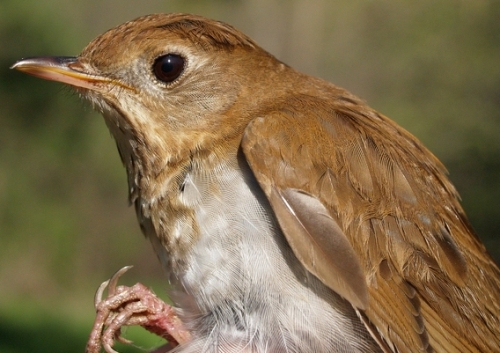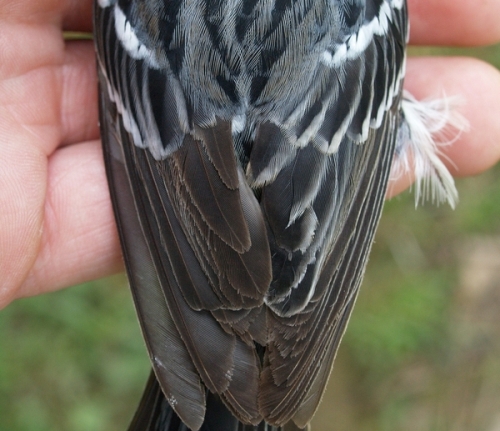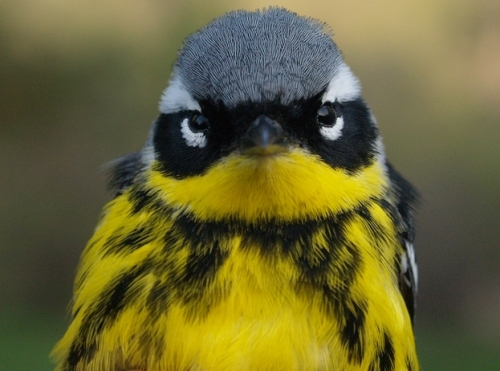|
|
THIS WEEK |
THIS SPRING |
2011 TOTAL |
SITE TOTAL |
|
# birds (and species) banded |
129 (30) |
424 (44) |
495 (48) |
32064 (107) |
|
# birds (and species) repeat |
11 (7) |
45 (16) |
53 (16) |
5560 (68) |
|
# birds (and species) return |
8 (5) |
34 (16) |
58 (16) |
865 (37) |
|
# species observed |
94 |
119 |
123 |
202 |
|
# net hours |
400.0 |
1511.0 |
1534.0 |
51151.1 |
|
# birds banded / 100 net hours |
32.3 |
28.1 |
32.3 |
62.7 |
|
|
Note: table does not include nocturnal banding (owls) |
Banders-in-charge: Simon Duval, Gay Gruner, Lance Laviolette
Intern: Matthew Von Bornhoft
Assistants: Christine Barrie, Nicolas Bernier, David Bird, Rui De Jesus, Rejean Duval, Tammy Eliott, Jeff Harrison, Lisa Keelty, Francine Marcoux, Barbara MacDuff, Chris Murphy, Benoit Piquette, Francine Piquette, Elise Titman, Rodger Titman
Notes: Once again this week rain interfered with operations, wiping out banding on both Saturday and Sunday. This was all the more unfortunate given that the 62 birds banded on Friday tied our second-highest single day total in the history of our Spring Migration Monitoring Program. Although the rain prevented us from opening nets on the weekend, census observations showed that there were still many birds around, so we hope that the weather will clear and allow us to have some productive banding sessions in week 8 before all these migrants move on. The 67 species observed on Friday is also among the highest single-day counts in MBO’s history, and the best ever prior to mid-May. This boded well for the MBO Green Team’s Birdathon on Saturday, which observed 44 species just along the census trail, and ended up with a total of 87 for the day, all within Ste-Anne-de-Bellevue – click here for the full report.
Despite the rain, the 43 species and 129 individuals banded this week are remarkably close to our six-year average for week 7, of 41 species and 127 individuals. Similarly, the 119 species observed to this point in the season is just barely ahead of the average of 116 over the past six years. In contrast, we have had unusually few returns so far this spring, with only 34 individuals recaptured that we banded in previous years, compared to an average of 55 by this point over the past five spring seasons (omitting 2005 from this comparison, since it was our first full spring, so fewer returns were possible). It will be interesting to see whether these individuals are just late in coming back to MBO this year, or not returning at all. However, among this week’s returns we did have a particularly interesting one in the form of a Veery banded at MBO in August 2006, recaptured in spring 2007, but not recorded again until this week.
Among the 119 species observed that we mentioned above, 21 made their first appearance for 2011 during the past week: Black-crowned Night Heron, Lesser Yellowlegs, Ruby-throated Hummingbird, Least Flycatcher, Warbling Vireo, Northern Rough-winged Swallow, Bank Swallow, Veery, Swainson’s Thrush, Wood Thrush, Tennessee Warbler, Northern Parula, Blackburnian Warbler, Bay-breasted Warbler, Black-throated Blue Warbler, Blackpoll Warbler, American Redstart, Ovenbird, Scarlet Tanager, Lincoln’s Sparrow, and House Finch. The Black-crowned Night Heron was only the fifth record for MBO, all of them occurring in spring, and the first since April 2009. The Lesser Yellowlegs was an even more rare visitor, with only two previous records, in May and August of 2008. This week we also banded 12 species for the first time this year: Least Flycatcher, Warbling Vireo, Gray Catbird, Nashville Warbler, Yellow Warbler, Magnolia Warbler, Chestnut-sided Warbler, Black-throated Blue Warbler, Blackpoll Warbler, American Redstart, Northern Waterthrush, and Lincoln’s Sparrow. This marks the first time we have banded a Blackpoll Warbler prior to week 8, and is only the second time we have even observed the species at MBO before mid-May.
This week’s
top 10
#
individuals banded |
mean # individuals observed daily |
1. Red-winged Blackbird (23) [4] |
1. Canada Goose (120) [1] |
2. Yellow-rumped Warbler (22) [3] |
2. Red-winged Blackbird (47) [2] |
3. Cedar Waxwing (9) [7] |
3. Yellow-rumped Warbler (29) [7] |
3. Common Yellowthroat (9) [7] |
4. Ring-billed Gull (22) [-] |
5. Yellow Warbler (7) [-] |
5. American Crow (17) [6] |
5. White-throated Sparrow (7) [1] |
6. White-throated Sparrow (14) [5] |
5. White-crowned Sparrow (7) [-] |
7. Cedar Waxwing (10) [3] |
8. Magnolia Warbler (6) [-] |
8. Tree Swallow (9) [-] |
9. Ruby-crowned Kinglet (5) [1] |
8. Black-capped Chickadee (9) [8] |
9. Lincoln's Sparrow (5) [-]
|
10. American Goldfinch (8) [-] |
|
There was considerable turnover in this week’s list of species banded, with four new species added to the top 10 (displacing Swamp Sparrow, American Robin, Hairy Woodpecker, and all four of the species tied for 10th spot last week: Black-capped Chickadee, House Wren, Black-and-white Warbler, and American Goldfinch). Also, the two species tied for the top spot last week (Ruby-crowned Kinglet and White-throated Sparrow) were knocked down to the bottom half of this week’s list. Red-winged Blackbird was number one this week, as has been the case for week 7 in four of six previous years. It was followed closely by another strong showing from Yellow-rumped Warbler, which has now eclipsed its previous spring high of 47 individuals banded, set in 2008. The 5 Lincoln’s Sparrows this week was noteworthy, given that in four of six previous spring programs, the season total for this species was 5 or fewer. Although overall a rather common species at MBO in spring, Cedar Waxwing has typically been scarce during the second and third weeks of May, and only one individual had previously been banded in week 7, so this week’s third place ranking was quite a surprise.
Yet again, for a fourth consecutive week, Canada Goose topped the list of species observed by a wide margin over Red-winged Blackbird in second place. Although this ranking is the same as last year, and Canada Goose also took top spot for week 7 in 2009, the mean count this week is more than double the highest previous record for this time of year and reflects the continued passage of large flocks of migrants much later than usual. Although this is traditionally the peak week for spring migration of Yellow-rumped Warbler, the counts this week were still surprisingly high, nearly double the previous record observed in 2008, and close to four times the mean count for week 7 over the past six years. The remainder of the top ten is a fairly typical mix of May migrants and local residents.
|

This Veery was banded at MBO on August 8, 2006, and was recaptured this week on May 12, for the first time since 2007.
(Photo by Simon Duval)

Among the many Yellow-rumped Warblers banded this week was this second-year male with an unusually asymmetrical molt of its tertials and inner secondaries.
(Photo by Simon Duval)
|



